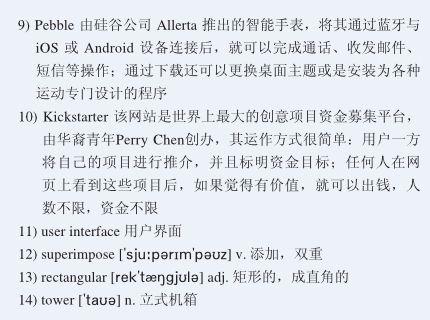苹果手表,谷歌眼镜
by Parmy Olson
Mobile technology is breathing new life into devices we once thought were rather boring—like watches. A year ago, who needed to buy a watch when you could pull a smartphone out of your pocket and read the time on a brightly-lit screen? Yet that sentiment may change soon enough.
Apple is betting consumers will have found the pulling-out-of-the-pocket 1)manoeuvre too tiring once they realize they can simply glance at their wrist to check the time, along with their email, social media notifications and heart rate. Apple has around 100 people working on a watch-like device that could come this year, according to Bloomberg News and 2)The Verge, and its rumored to be called the iWatch, running 3)parallel to that other big wearable device product in the works in Silicon Valley: Google Glass.
Where might that leave smartphones?
In the U.S., Europe and parts of Asia which are deeply 4)saturated with smart, mobile devices, consumers may eventually decide the smartest machines they own are no longer pocketable 5)slabs for wireless communication, but the watch or glasses they can wear and barely have to handle.
移动技术让一些我们曾一度认为相当无趣的设备——例如手表,焕发了生机。一年前,当人们可以从口袋里掏出一部智能手机,在其光亮的屏幕上读取时间,谁还要买手表呢?然而,这种观念可能很快就要转变了。
苹果公司押注:一旦消费者意识到他们只需瞄一眼手腕就可以查看时间,附带还能查看邮件、社交媒体信息以及心率时,他们就会觉得从口袋里掏手机也太麻烦了。据彭博新闻社和科技网站The Verge报道,苹果公司约有100名员工正致力于研发这种手表样的设备,并且可能于今年推出。有传这个产品将被命名为iWatch,与硅谷另一款强大的可佩戴设备——谷歌眼镜并驾齐驱。
这可能将智能手机置于何种境地呢?
在美国、欧洲和亚洲部分智能移动设备高度饱和的地区,消费者们最终可能会认为他们所拥有的最智能的设备将不再是用于无线通信的口袋平板,而是可以佩戴且几乎无需手持的腕表或眼镜。
One possible result: smartphones are no longer “smart,” but relegated back to their old role of providing basic wireless communication and nothing more.
In fact, if the designers of the iWatch and Google Glass can figure out a seamless way to work with earphones and mics, and these devices have their own 6)SIM cards, who knows if smartphones as we know them will even be needed?
For one thing, consumers would still want a decent display for viewing content. In this case, smartphones could be replaced with cheaper,“7)dumb screens” that can connect, via 8)WiFi or bluetooth, with the more powerful processing power in the wearable device.
一种可能的结局是:智能手机不再“智能”,而是被打回原形,即回复到只提供基本无线通信功能的旧貌,除此之外别无他用。
实际上,如果苹果手表和谷歌眼镜的设计者们能够找到一种方式无缝兼容耳机和话筒的使用,并且这些设备还能装上自己的电话SIM卡,谁知道如今我们熟知的智能手机是否还有市场呢?
首先,消费者仍会想要一个像样的屏幕来浏览信息。在这种情况下,智能手机可能会被更为便宜的“笨屏幕”所取代,这些屏幕可以通过无线局域网或蓝牙,与可佩戴设备中更强大的处理器相连。
Another option is that the smartphone as a slab still exists, and remains the wireless “hub”that contains a SIM card and processing power, but it also becomes a device that we dont interact with as much anymore and therefore becomes cheaper. (The case for a cheaper iPhone in developed markets becomes stronger here too.) You can leave the phone in your bag, and not worry about hearing it ring because you have your iWatch on.
“It replaces the compulsive need to turn on your phone and check whos been calling you,”says Vinita Jakhanwal, director of mobile and emerging displays with IHS iSuppli.
A current example of this idea comes from 9)Pebble, an e-paper watch that has raised $10 million in funding on 10)Kickstarter and is perhaps the most well-known of the forthcoming wave of smart watches. It uses Bluetooth to harness the functionality and processing power of a smartphone to display its notifications.
Jakhanwal says a wearable device like Google Glass probably wouldnt need a second screen, since the device can project a fairly large display. But she also questions how viable a product Glass is, knowing that 3D television has struggled to catch on. “Consumers dont take to wearing something on their eyes very easily,” she says.
另一种可能是,智能手机作为平板依然存在,并且仍然是保有SIM卡和处理能力的无线“中心”,但它也成为消费者们不再频繁互动的设备,因此价格变得更为便宜。(苹果手机的价格在成熟市场日趋低廉的理由在这里也变得更加充分。)你大可以把手机放到包里,不必担心听不到手机响,因为你戴着苹果手表。
“有了这玩意儿,你不需要再强迫症一般查看手机,看谁给你致电了。”市场研究公司IHS iSuppli的移动及新兴显示业务总监维尼塔·捷克纳瓦尔如是说。
这一想法的当下例子来自Pebble智能手表,这款电子纸手表已经在众筹网站Kickstarter上募得1000万美元,可能是未来智能手表浪潮中最知名的产品。它运用蓝牙来驾驭智能手机的功能和处理能力以显示通告信息。
捷克纳瓦尔表示,像谷歌眼镜这样的可佩戴设备可能不需要第二块屏,因为该设备可以投射出一块相当大的显示屏。但她也质疑谷歌眼镜作为产品的可延续性,因为她很清楚如今3D电视的推广遭遇困境。“消费者不会轻易在自己的眼前戴上任何东西。”她如是说。
So if wearable watches rise, could we also see “dumb displays” replacing smartphones? “Whats not very clear right now is what your 11)user interface is going to be with these new types of devices. Google Glass works with voice…but a lot of work still needs to be done to make those kinds of interfaces easy and accurate to use,” says Jakhanwal. “It could also be gesture as a user interface rather than touch.”
Some concept devices have even used the blinking eye as an interface method. “How you 12)superimpose your basic iOS and device with user interaction will be critical to making these devices successful,” she says.
One thing to note: if wearable devices do send 13)rectangular smartphones the way of the PC 14)tower, it wont be for years yet. The mobile market is too huge for that. Roughly 1.2 billion mobile phones were sold in 2012 alone, and around 800 million of them were smartphones, Jakhanwal notes.“The smartphone market will not go away.”
那么如果可佩戴的智能手表兴起,我们会看到“笨显示器”取代智能手机吗?捷克纳瓦尔说:“现在尚不清楚的是,这些新型设备的用户界面会是怎么样的。谷歌眼镜支持语音……但是要让那种界面简单易用,精准操作,还需要下很多工夫。成为用户界面的还可能是手势而非触摸操作。”
一些概念设备已经甚至使用到了眨眼动作作为一种交互方式。“如何在基本的iOS操作系统和设备上加上用户交互将成为这些设备成功与否的关键所在。” 贾汉维尔说。
值得注意的一点是:如果可佩戴设备的确能使方方正正的智能手机重蹈个人电脑主机的覆辙,那也不会在近年内发生。移动市场巨大,还不至于这么快。捷克纳瓦尔指出,单是2012年,售出的手机就约有12亿部,其中大概有8亿部为智能手机。“智能手机的市场不会消逝。”

